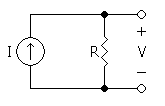Ohm's Law
Related wiki pages : Electronic Theory, Voltage, Current, Impedance, Resistors
What is it?
Ohm's Law is named after Georg Ohm, a German physicist who postulated it in 1827. His treatise described measurements of voltage and current in simple circuits, using various lengths of wire as resistors. The following diagram shows a voltage source V passing through a resistor R creating a current I
The following diagram shows a current source I through a resistor R, causing a potential drip (voltage V)
Ohm's Law states that the current that passes between two points on a conductor is directly proportional to the potential difference (voltage) between the points and inversely proportional to the to the resistance of the conductor between the points.
so, <math>I = \frac{V}{R}</math>
where
- "I" is the current in amperes,
- "V" is the potential difference between the ends of the resistor in volts, and
- "R" is the resistance of the resistor, measured in ohms
Ohms Law can also be used in impedance (resistance to AC) calculations thus:
<math>I = \frac{V}{Z}</math>
where
- "I" is the current in amperes,
- "V" is the potential difference between the ends of the resistor in volts, and
- "Z" is the Impedance (AC resistance) of the resistor, measured in ohms
| Electronic Theory | |
| Physical quantities | Current * Gain * Impedance * Power * Q of a circuit * Radiated Power Measurement * Reactance* Resistivity * Resonance * Voltage |
| Components | Baluns * Bipolar-Junction Transistors * Capacitors * Diodes * Inductors* Lasers * Microphones * Resistors * Transformers * Wire |
| Circuits | Attenuators * Digital Signal Processing (DSP) * Dummy load * Filters * LC filters * Power Supply Design * Rectifier Circuits |
| Design | Amplifier Design * Oscillator Design |
| Electromagnetic Waves | Relative power (Decibels) * Harmonics * Interference and BPL |

